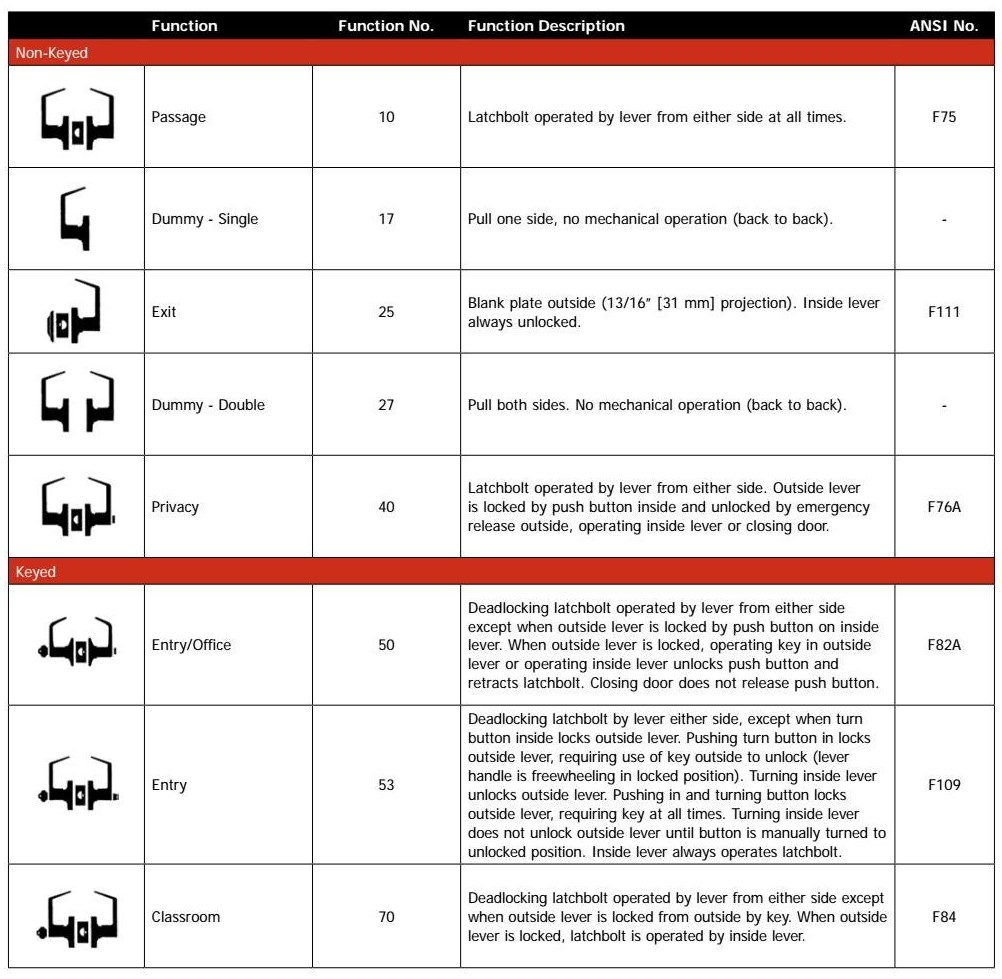Despite their similar appearances, locks can perform significantly differently. In order to simplify understanding them, over 20 different lock functions have been defined by widely accepted industry standards. When selecting a lock for a job an understanding of them is required. Otherwise security vulnerabilities can occur or dangers to life and safety could occur.
Common Functions
An opening should be specified based on the function of a lock. Especially for the use of a cylindrical lever or mortise lock. In everyday use, you can compare the function of a restroom lock (Privacy Function) with that of a storage closet lock (Storeroom Function).
Bathroom locks are defined as having the ability to be locked from the inside, which protects privacy. A similar feature is applied to storage closets, simply to prevent children and incapacitated people from being trapped inside if the door is accidentally locked shut.
Per Building Occupancy Codes and Access Control Life/Safety Codes, integration of mechanical locksets into electronic access is critical. By not understanding how electronic hardware works, one may use it improperly or illegally.
An example includes, a mortise lock with a separate deadbolt may require an electric strike that can accommodate more than one latch, or two strikes may be needed. In addition, some Deadlock functions when used will remain locked unless the key is unlocked from the outside. A maglock alone will not allow the door to be released if access is gained, potentially resulting in death or injury during an evacuation.
Lock Functions And Codes
More than 20 different functions are available for locks, and these properties are identified by codes.
Prior to the implementation of codes, functions were described using common labels such as ‘Passage Functions’ or ‘Privacy Locks’. Label variations are common among manufacturers and regions, so simply identifying these locks by common labels does not guarantee they will function correctly, so alphanumeric codes are important for clarification.

Some occupancies forbid some functions, such as a ‘Double Keyed Deadbolt’ in most group occupancies, while others require its use exclusively in ‘Hotels/Motels’.
The lock function is easy to locate with commercial-grade hardware – it is generally listed on cutsheets. It’s also important to be aware that different variations of the same SKU can have different functions. Making sure you order the right function is crucial because it is difficult to change it in the field.
The majority of commercial and residential hardware is commonly sold as ‘office locks’ or ‘bathroom locks’ with no function codes specified. Due to their limited configuration, these products may not meet codes or specifications.
If you are looking to update security features for your business, like Security Locks let RC Security help. Our continued research and partnerships with premium brands allow us to offer better quality every time.
About RC Security Consulting
RC Security Consulting protects the heart of Texas with design, installation, retrofit, repair, inspection, and monitoring of commercial security systems. We are centrally located in Collin County and provide service for almost 200 miles in all directions. Connect with us on LinkedIn to learn more.


